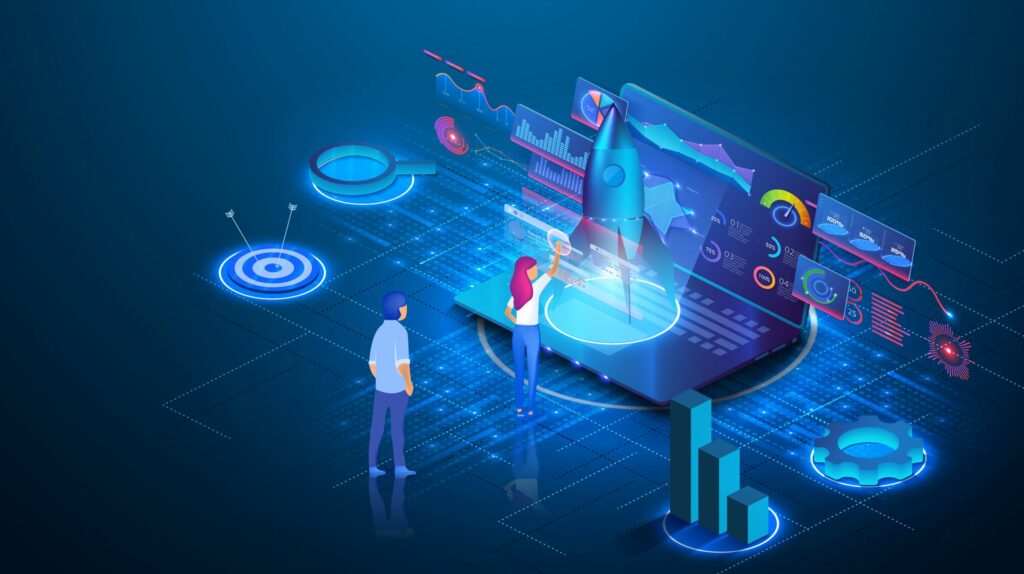As more and more of our daily lives become digitized, cyber security threats are becoming increasingly prevalent and sophisticated. Cyberattacks can take many forms, from phishing emails to a ransomware attack, and can result in the loss of sensitive information, financial loss, and damage to an organization’s reputation.
The impact of a successful cyberattack can be devastating, and the cost of recovering from such an attack can be staggering.
In order to protect your organization against cyber security threats, it is important to take a proactive approach to cybersecurity. This means investing in the right tools and technologies, educating employees about best practices for online and security awareness, and staying up to date on the latest threats and trends in the cybersecurity landscape.

One of the most important steps in protecting your organization against cyber security threats is implementing strong security measures across all of your digital assets.
This includes EDR (Endpoint Detection and Response) tools such as Microsoft Defender for Endpoint or Crowdstrike, firewalls, Multifaction Authentication, network segmentation, awareness training, and other cyber security tools that can help detect and prevent attacks before they can cause damage.
This should also be monitored 24/7 by a Security Operations Center (SOC) with highly skilled analysts investigating every alarm that comes in. This can be an in-house SOC or outsourced (SOC as a Service) to a MDR/MSSP, each has their own benefits.
Additionally, it is important to implement strong authentication protocols, such as two-factor authentication or biometric authentication, to ensure that only authorized users can access the target system.
Education is also a critical component of protecting your organization against cyber security threats. This means educating employees about the risks of phishing emails and other types of cyberattacks, and providing training on how to identify and report suspicious activity.
Regularly testing employees’ knowledge and understanding of cybersecurity best practices can also help the security teams ensure that they remain vigilant and aware of potential threats.
Another key component of protecting your organization against cyber security threats is staying up to date on the latest threats and trends in the cybersecurity landscape. This includes staying informed about new types of attacks, emerging technologies, and best practices for mitigating risk.
By staying informed and proactive, you can help ensure that your organization is well-prepared to defend against even the most sophisticated cyberattacks.
In this article, we will discuss some of the most common cyber threats and security solutions and how organizations can protect themselves against them.
What are the top security threats in security?
Cybersecurity threats come in many forms, including malware, phishing attacks, ransomware, Distributed Denial of Service (DDoS) attacks, and social engineering. Malware is malicious software designed to damage, disrupt, or control computer systems or networks.
Phishing attacks are attempts to trick users into providing sensitive information, such as entering login credentials or credit card numbers on a fake website.
Ransomware is a type of malware that encrypts data and demands a ransom to unlock it. DDoS attacks are designed to overload a website or network, making it inaccessible to users. Social engineering attack is the use of psychological manipulation to trick users into divulging sensitive information.
What are the emerging security threats?
As technology evolves, new threats emerge, such as AI-based attacks, cloud-based attacks, and IoT attacks. AI-based attacks use machine learning to create customized and sophisticated attacks and malicious code that can bypass traditional security measures.
Cloud-based attacks target vulnerabilities in cloud-based services and applications. IoT attacks target internet-connected devices, such as smart homes, cars, mobile devices and medical devices, which are vulnerable devices often poorly secured and susceptible to attacks.

What are the 4 categories of threats?
The four categories of cybersecurity threats are external, internal, intentional, and unintentional.
- External threats come from outside the organization, such as ranswomware groups, nation state hackers or activists.
- Internal threats come from within the organization, such as disgruntled employees or contractors. Also called Insider Threat, or malicious insiders.
- Intentional threats are deliberate attacks aimed at causing harm,
- Unintentional threats are caused by human error or negligence.
What is the biggest cyber threat in 2023?
It’s difficult to predict the biggest cyber threats in 2023, but ransomware and data extortion (or both, a “double ransom” will continue to be a plague, while AI-based attacks, and supply chain attacks are likely to be major cyber threats.
The quick evolution of AI tools such as ChatGPT is another threat to factor in as it is integrated into cyber security and also lowers the skills threshold for threat actors even more.
Ransomware attacks have increased in frequency and sophistication in recent years, making them a significant threat to organizations. Supply chain attacks target third-party vendors and suppliers, making them difficult to detect and prevent.

What are the top 10 security threats?
The top 10 cyber crime and security threats include:
- Phishing attacks
- Ransomware
- Data extortion
- DDoS attacks
- Insider threats
- IoT attacks
- Cloud-based attacks
- AI-based attacks
- Social engineering
- Supply chain attacks
Phishing Attacks
Phishing attacks are one of the most common types of cyber attacks. These attacks involve a threat actor sending a fake email, text message, or other communication that appears to be from a legitimate source, such as a bank or social media platform, or a fake login page to Microsoft/Google etc. The goal of the threat actor is to trick the recipient into providing sensitive information, such as login credentials or credit card numbers.
Ransomware
Ransomware is a type of malware which is malicious code that encrypts files on a victim’s computer or network and demands a ransom payment in exchange for the decryption key. These attacks can be extremely damaging, as they can result in the loss of important data and can be difficult to recover from.
Data extortion
This involves stealing sensitive information and threatening to release it publicly or to sell it to the highest bidder. The goal here is always to steal data and confidential information for financial gain. These data breaches can be financially devastating and can damage an organization’s reputation.
DDoS Attacks
Distributed Denial of Service (DDoS) attacks are designed to overload a website or network, making it inaccessible to users. These cyber attacks typically involve a large number of devices (a botnet) of computers or IoT devices, that are infected with malware and used to flood the targeted network with traffic.
Insider Threats
Insider threats are attacks that are carried out by employees or other trusted insiders. These attacks can be intentional, such as stealing sensitive data, or unintentional, such as accidentally sending an email to the wrong recipient.
Credential Stuffing
Credential stuffing attacks are designed to exploit vulnerabilities in authentication systems. In these attacks, the threat actors uses stolen login credentials, such as usernames and passwords, to steal sensitive data or gain access to an account or network.
IoT Attacks
Internet of Things (IoT) devices, such as smart home devices or medical devices, are becoming increasingly popular and are often poorly secured. An IoT cyber attack involve exploiting vulnerabilities in these devices to gain access to confidential information or cause damage.
Cloud-based Attacks
Cloud-based attacks target vulnerabilities in cloud-based services and applications. These attacks can be difficult to detect and prevent, as the attackers often use legitimate credentials to gain access to the cloud resources.
AI-based Attacks
AI-based attacks use machine learning to create customized and sophisticated attacks that can bypass traditional security measures. These attacks are expected to become more common as machine learning is integrated into cybersecurity.
Social Engineering
Social engineering attacks is the use of psychological manipulation to trick users into divulging sensitive information. These attacks can take many forms, such as phishing or pretexting.
Supply Chain Attacks – Supply chain attacks target third-party vendors and suppliers to gain access to an organization’s network or data. These attacks can be difficult to detect and prevent, as the attackers often use legitimate credentials to gain access to the supply chain. While this can be applied to the hardware supply chain, we often mean the software supply chain attack where the cyber criminals inject malicious code and install malware.
What can my organization do to protect against these attacks?
Organizations can protect themselves against cyber security threats by constantly improving their security posture by for example implementing a multi-layered defense strategy. This includes technical controls, with EDR (Endpoint Detection and Response) tools such as Microsoft Defender for Endpoint or Crowdstrike, firewalls, Multifaction Authentication, network segmentation, awareness training, and other security tools that can help detect across the whole spectrum from common security threats to advanced persistent threats.
Ideally you monitor this 24/7 in a Security Operations Center (SOC) with a specialized team of SOC analysts. This SOC could be in-house SOC or partnering with a MDR/MSSP to do this more effectively and almost always cheaper.

When the security controls and counter measures above are in place, organizations should implement threat hunting the use of threat intelligence data to prevent data breaches by cyber criminals.
Vulnerability management is a very important function to have in place to protect your critical infastructure, to update your applications and operating system in order to patch system vulnerabilities which the vulnerability scan detects.
As just said, it’s important to regularly update your operating system, software and applications, but also to use strong passwords and two-factor authentication for user accounts, and have security controls that limit access to any sensitive data and information from cyber attacks.
Organizations should also have a plan in place for responding to security incidents, including regular backups (and the testing of these backups) of critical data.
In conclusion, cyber security threats are constantly evolving and are increasingly sophisticated, and it’s critical for organizations to stay vigilant and take steps to protect themselves.
By understanding the types of cyber threats and implementing a comprehensive defense strategy, organizations can reduce the risk of security incidents and minimize the damage if an incident does occur.






